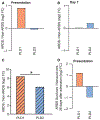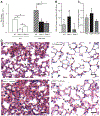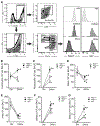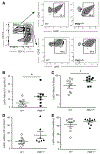Phospholipase D isoforms differentially regulate leukocyte responses to acute lung injury
- PMID: 29437245
- PMCID: PMC6375305
- DOI: 10.1002/JLB.3A0617-252RR
Phospholipase D isoforms differentially regulate leukocyte responses to acute lung injury
Abstract
Phospholipase D (PLD) plays important roles in cellular responses to tissue injury that are critical to acute inflammatory diseases, such as the acute respiratory distress syndrome (ARDS). We investigated the expression of PLD isoforms and related phospholipid phosphatases in patients with ARDS, and their roles in a murine model of self-limited acute lung injury (ALI). Gene expression microarray analysis on whole blood obtained from patients that met clinical criteria for ARDS and clinically matched controls (non-ARDS) demonstrated that PLD1 gene expression was increased in patients with ARDS relative to non-ARDS and correlated with survival. In contrast, PLD2 expression was associated with mortality. In a murine model of self-resolving ALI, lung Pld1 expression increased and Pld2 expression decreased 24 h after intrabronchial acid. Total lung PLD activity was increased 24 h after injury. Pld1-/- mice demonstrated impaired alveolar barrier function and increased tissue injury relative to WT and Pld2-/- , whereas Pld2-/- mice demonstrated increased recruitment of neutrophils and macrophages, and decreased tissue injury. Isoform-specific PLD inhibitors mirrored the results with isoform-specific Pld-KO mice. PLD1 gene expression knockdown in human leukocytes was associated with decreased phagocytosis by neutrophils, whereas reactive oxygen species production and phagocytosis decreased in M2-macrophages. PLD2 gene expression knockdown increased neutrophil and M2-macrophage transmigration, and increased M2-macrophage phagocytosis. These results uncovered selective regulation of PLD isoforms after ALI, and opposing effects of selective isoform knockdown on host responses and tissue injury. These findings support therapeutic strategies targeting specific PLD isoforms for the treatment of ARDS.
Keywords: Phospholipase D; acute lung injury; acute respiratory distress syndrome; microarray.
©2018 Society for Leukocyte Biology.
Conflict of interest statement
DISCLOSURES
The authors declare no conflicts of interest.
Figures






References
-
- Bellani G, Laffey JG, Pham T, et al. Epidemiology, patterns of care, and mortality for patients with acute respiratory distress syndrome in intensive care units in 50 countries. JAMA. 2016;315(8):788–800. - PubMed
-
- Kolaczkowska E, Kubes P. Neutrophil recruitment and function in health and inflammation. Nat Rev Immunol 2013;13(3):159–175. - PubMed
Publication types
MeSH terms
Substances
Grants and funding
LinkOut - more resources
Full Text Sources
Other Literature Sources
Molecular Biology Databases
Research Materials
Miscellaneous

